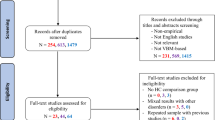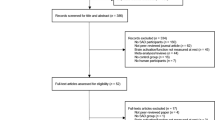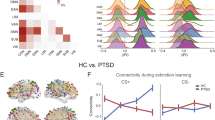Abstract
Decades of psychosis research highlight the prevalence and the clinical significance of negative emotions, such as fear and anxiety. Translational evidence demonstrates the pivotal role of the amygdala in fear and anxiety. However, most of these approaches have used hypothesis-driven analyses with predefined regions of interest. A data-driven analysis may provide a complimentary, unbiased approach to identifying brain correlates of fear and anxiety. The aim of the current study was to identify the brain basis of fear and anxiety in early psychosis and controls using a data-driven approach. We analyzed data from the Human Connectome Project for Early Psychosis, a multi-site study of 125 people with psychosis and 58 controls with resting-state fMRI and clinical characterization. Multivariate pattern analysis of whole-connectome data was used to identify shared and psychosis-specific brain correlates of fear and anxiety using the NIH Toolbox Fear-Affect and Fear-Somatic Arousal scales. We then examined clinical correlations of Fear-Affect scores and connectivity patterns. Individuals with psychosis had higher levels of Fear-Affect scores than controls (p < 0.05). The data-driven analysis identified a cluster encompassing the amygdala and hippocampus where connectivity was correlated with Fear-Affect score (p < 0.005) in the entire sample. The strongest correlate of Fear-Affect was between this cluster and the anterior insula and stronger connectivity was associated with higher Fear-Affect scores (r = 0.31, p = 0.0003). The multivariate pattern analysis also identified a psychosis-specific correlate of Fear-Affect score between the amygdala/hippocampus cluster and a cluster in the ventromedial prefrontal cortex (VMPFC). Higher Fear-Affect scores were correlated with stronger amygdala/hippocampal-VMPFC connectivity in the early psychosis group (r = 0.33, p = 0.002), but not in controls (r = −0.15, p = 0.28). The current study provides evidence for the transdiagnostic role of the amygdala, hippocampus, and anterior insula in the neural basis of fear and anxiety and suggests a psychosis-specific relationship between fear and anxiety symptoms and amygdala/hippocampal-VMPFC connectivity. Our novel data-driven approach identifies novel, psychosis-specific treatment targets for fear and anxiety symptoms and provides complimentary evidence to decades of hypothesis-driven approaches examining the brain basis of threat processing.
This is a preview of subscription content, access via your institution
Access options
Subscribe to this journal
Receive 12 print issues and online access
$259.00 per year
only $21.58 per issue
Buy this article
- Purchase on Springer Link
- Instant access to full article PDF
Prices may be subject to local taxes which are calculated during checkout






Similar content being viewed by others
Data availability
Data presented in the present work was collected and minimally processed by the Human Connectome Project, specifically the early psychosis subgroup and sites. Statistics, analysis scripts, and figures are available from the corresponding author upon reasonable request.
References
Kessler RC, Birnbaum H, Demler O, Falloon IR, Gagnon E, Guyer M, et al. The prevalence and correlates of nonaffective psychosis in the National Comorbidity Survey Replication (NCS-R). Biol Psychiatry. 2005;58:668–76.
Charlson FJ, Ferrari AJ, Santomauro DF, Diminic S, Stockings E, Scott JG, et al. Global epidemiology and burden of schizophrenia: findings from the global burden of disease study 2016. Schizophr Bull. 2018;44:1195–203.
Bleuler E. Dementia Praecox, or the Group of Schizophrenia: International University Press. 1911.
Buchanan RW, Carpenter WT. Domains of psychopathology: an approach to the reduction of heterogeneity in schizophrenia. J Nerv Ment Dis. 1994;182:193–204.
Carpenter WT, Kirkpatrick B. The heterogeneity of the long-term course of schizophrenia. Schizophr Bull. 1988;14:645–52.
Harrow M, Grossman LS, Jobe TH, Herbener ES. Do patients with schizophrenia ever show periods of recovery? A 15-year multi-follow-up study. Schizophr Bull. 2005;31:723–34.
Kraeplin E. Lectures on clinical psychiatry: William Wood & Co. 1904.
Blanchard JJ, Mueser KT, Bellack AS. Anhedonia, positive and negative affect, and social functioning in schizophrenia. Schizophr Bull. 1998;24:413–24.
Pallanti S, Quercioli L, Hollander E. Social anxiety in outpatients with schizophrenia: a relevant cause of disability. Am J Psychiatry. 2004;161:53–8.
Taiminen T, Huttunen J, Heilä H, Henriksson M, Isometsä E, Kähkönen J, et al. The Schizophrenia Suicide Risk Scale (SSRS): development and initial validation. Schizophr Res. 2001;47:199–213.
Achim AM, Maziade M, Raymond E, Olivier D, Mérette C, Roy MA. How prevalent are anxiety disorders in schizophrenia? A meta-analysis and critical review on a significant association. Schizophr Bull. 2011;37:811–21.
Fusar-Poli P, Estradé A, Stanghellini G, Venables J, Onwumere J, Messas G, et al. The lived experience of psychosis: a bottom-up review co-written by experts by experience and academics. World Psychiatry. 2022;21:168–88.
Myin-Germeys I, van Os J. Stress-reactivity in psychosis: evidence for an affective pathway to psychosis. Clin Psychol Rev. 2007;27:409–24.
Davis M. The role of the amygdala in fear and anxiety. Annu Rev Neurosci. 1992;15:353–75.
Davis M. Neural systems involved in fear and anxiety measured with fear-potentiated startle. Am Psychol. 2006;61:741–56.
LeDoux JE, Pine DS. Using neuroscience to help understand fear and anxiety: a two-system framework. Am J Psychiatry. 2016;173:1083–93.
LeDoux J. The emotional brain, fear, and the amygdala. Cell Mol Neurobiol. 2003;23:727–38.
Shackman AJ, Fox AS. Contributions of the central extended amygdala to fear and anxiety. J Neurosci. 2016;36:8050–63.
Shin LM, Liberzon I. The neurocircuitry of fear, stress, and anxiety disorders. Neuropsychopharmacology. 2010;35:169–91.
Chavanne AV, Robinson OJ. The overlapping neurobiology of induced and pathological anxiety: a meta-analysis of functional neural activation. Am J Psychiatry. 2021;178:156–64.
Robinson OJ, Pike AC, Cornwell B, Grillon C. The translational neural circuitry of anxiety. J Neurol Neurosurg Psychiatry. 2019;90:1353–60.
Myin-Germeys I, van Os J, Schwartz JE, Stone AA, Delespaul PA. Emotional reactivity to daily life stress in psychosis. Arch Gen Psychiatry. 2001;58:1137–44.
Holt DJ, Kunkel L, Weiss AP, Goff DC, Wright CI, Shin LM, et al. Increased medial temporal lobe activation during the passive viewing of emotional and neutral facial expressions in schizophrenia. Schizophr Res. 2006;82:153–62.
Hall J, Whalley HC, McKirdy JW, Romaniuk L, McGonigle D, McIntosh AM, et al. Overactivation of fear systems to neutral faces in schizophrenia. Biol Psychiatry. 2008;64:70–3.
Anticevic A, Van Snellenberg JX, Cohen RE, Repovs G, Dowd EC, Barch DM. Amygdala recruitment in schizophrenia in response to aversive emotional material: a meta-analysis of neuroimaging studies. Schizophr Bull. 2012;38:608–21.
Dugré JR, Bitar N, Dumais A, Potvin S. Limbic hyperactivity in response to emotionally neutral stimuli in schizophrenia: a neuroimaging meta-analysis of the hypervigilant mind. Am J Psychiatry. 2019;176:1021–9.
Anticevic A, Tang Y, Cho YT, Repovs G, Cole MW, Savic A, et al. Amygdala connectivity differs among chronic, early course, and individuals at risk for developing schizophrenia. Schizophr Bull. 2014;40:1105–16.
Liu H, Tang Y, Womer F, Fan G, Lu T, Driesen N, et al. Differentiating patterns of amygdala-frontal functional connectivity in schizophrenia and bipolar disorder. Schizophr Bull. 2014;40:469–77.
Bjorkquist OA, Olsen EK, Nelson BD, Herbener ES. Altered amygdala-prefrontal connectivity during emotion perception in schizophrenia. Schizophr Res. 2016;175:35–41.
Feola B, McHugo M, Armstrong K, Noall MP, Flook EA, Woodward ND, et al. BNST and amygdala connectivity are altered during threat anticipation in schizophrenia. Behav Brain Res. 2021;412:113428.
Mukherjee P, Whalley HC, McKirdy JW, McIntosh AM, Johnstone EC, Lawrie SM, et al. Lower effective connectivity between amygdala and parietal regions in response to fearful faces in schizophrenia. Schizophr Res. 2012;134:118–24.
Mukherjee P, Whalley HC, McKirdy JW, Sprengelmeyer R, Young AW, McIntosh AM, et al. Altered amygdala connectivity within the social brain in schizophrenia. Schizophr Bull. 2014;40:152–60.
Levitt JJ, Zhang F, Vangel M, Nestor PG, Rathi Y, Cetin-Karayumak S, et al. The organization of frontostriatal brain wiring in non-affective early psychosis compared with healthy subjects using a novel diffusion imaging fiber cluster analysis. Mol Psychiatry. 2023;28:2301–11.
Birchwood M, Todd P, Jackson C. Early intervention in psychosis. The critical period hypothesis. Br J Psychiatry Suppl. 1998;172:53–9.
Pardo-de-Santayana G, Vázquez-Bourgon J, Gómez-Revuelta M, Ayesa-Arriola R, Ortiz-Garcia de la Foz V, Crespo-Facorro B, et al. Duration of active psychosis during early phases of the illness and functional outcome: The PAFIP 10-year follow-up study. Schizophr Res. 2020;220:240–7.
Avery SN, Clauss JA, Blackford JU. The human BNST: functional role in anxiety and addiction. Neuropsychopharmacology. 2016;41:126–41.
Davis M, Walker DL, Miles L, Grillon C. Phasic vs sustained fear in rats and humans: role of the extended amygdala in fear vs anxiety. Neuropsychopharmacology. 2010;35:105–35.
Fox AS, Oler JA, Tromp DP, Fudge JL, Kalin NH. Extending the amygdala in theories of threat processing. Trends Neurosci. 2015;38:319–29.
Goode TD, Maren S. Role of the bed nucleus of the stria terminalis in aversive learning and memory. Learn Mem. 2017;24:480–91.
Lebow MA, Chen A. Overshadowed by the amygdala: the bed nucleus of the stria terminalis emerges as key to psychiatric disorders. Mol Psychiatry. 2016;21:450–63.
Fox AS, Shackman AJ. The central extended amygdala in fear and anxiety: Closing the gap between mechanistic and neuroimaging research. Neurosci Lett. 2019;693:58–67.
Hur J, Smith JF, DeYoung KA, Anderson AS, Kuang J, Kim HC, et al. Anxiety and the neurobiology of temporally uncertain threat anticipation. J Neurosci. 2020;40:7949–64.
Shehzad Z, Kelly C, Reiss PT, Cameron Craddock R, Emerson JW, McMahon K, et al. A multivariate distance-based analytic framework for connectome-wide association studies. Neuroimage. 2014;93:74–94. Pt 1
Pilkonis PA, Choi SW, Salsman JM, Butt Z, Moore TL, Lawrence SM, et al. Assessment of self-reported negative affect in the NIH Toolbox. Psychiatry Res. 2013;206:88–97.
Spitzer RL, Kroenke K, Williams JB, Löwe B. A brief measure for assessing generalized anxiety disorder: the GAD-7. Arch Intern Med. 2006;166:1092–7.
Watson D, Weber K, Assenheimer JS, Clark LA, Strauss ME, McCormick RA. Testing a tripartite model: I. Evaluating the convergent and discriminant validity of anxiety and depression symptom scales. J Abnorm Psychol. 1995;104:3–14.
Pilkonis PA, Choi SW, Reise SP, Stover AM, Riley WT, Cella D, et al. Item banks for measuring emotional distress from the Patient-Reported Outcomes Measurement Information System (PROMIS®): depression, anxiety, and anger. Assessment. 2011;18:263–83.
Pilkonis PA, Yu L, Dodds NE, Johnston KL, Maihoefer CC, Lawrence SM. Validation of the depression item bank from the Patient-Reported Outcomes Measurement Information System (PROMIS) in a three-month observational study. J Psychiatr Res. 2014;56:112–9.
Kay SR, Fiszbein A, Opler LA. The positive and negative syndrome scale (PANSS) for schizophrenia. Schizophr Bull. 1987;13:261–76.
van der Gaag M, Hoffman T, Remijsen M, Hijman R, de Haan L, van Meijel B, et al. The five-factor model of the Positive and Negative Syndrome Scale II: a ten-fold cross-validation of a revised model. Schizophr Res. 2006;85:280–7.
Wallwork RS, Fortgang R, Hashimoto R, Weinberger DR, Dickinson D. Searching for a consensus five-factor model of the Positive and Negative Syndrome Scale for schizophrenia. Schizophr Res. 2012;137:246–50.
Yan CG, Wang XD, Zuo XN, Zang YF. DPABI: data processing & analysis for (resting-state) brain imaging. Neuroinformatics 2016;14:339–51.
Power JD, Barnes KA, Snyder AZ, Schlaggar BL, Petersen SE. Spurious but systematic correlations in functional connectivity MRI networks arise from subject motion. Neuroimage. 2012;59:2142–54.
Ling G, Lee I, Guimond S, Lutz O, Tandon N, Nawaz U, et al. Individual variation in brain network topology is linked to emotional intelligence. Neuroimage. 2019;189:214–23.
Nawaz U, Lee I, Beermann A, Eack S, Keshavan M, Brady R. Individual variation in functional brain network topography is linked to schizophrenia symptomatology. Schizophr Bull. 2021;47:180–8.
Ward HB, Beermann A, Nawaz U, Halko MA, Janes AC, Moran LV, et al. Evidence for schizophrenia-specific pathophysiology of nicotine dependence. Front Psychiatry. 2022;13:804055.
Sharma A, Wolf DH, Ciric R, Kable JW, Moore TM, Vandekar SN, et al. Common dimensional reward deficits across mood and psychotic disorders: a connectome-wide association study. Am J Psychiatry. 2017;174:657–66.
Shanmugan S, Wolf DH, Calkins ME, Moore TM, Ruparel K, Hopson RD, et al. Common and dissociable mechanisms of executive system dysfunction across psychiatric disorders in youth. Am J Psychiatry. 2016;173:517–26.
Satterthwaite TD, Vandekar SN, Wolf DH, Bassett DS, Ruparel K, Shehzad Z, et al. Connectome-wide network analysis of youth with Psychosis-Spectrum symptoms. Mol Psychiatry. 2015;20:1508–15.
Desikan RS, Ségonne F, Fischl B, Quinn BT, Dickerson BC, Blacker D, et al. An automated labeling system for subdividing the human cerebral cortex on MRI scans into gyral based regions of interest. Neuroimage. 2006;31:968–80.
Lebron-Milad K, Milad MR. Sex differences, gonadal hormones and the fear extinction network: implications for anxiety disorders. Biol Mood Anxiety Disord. 2012;2:3.
Bangasser DA, Cuarenta A. Sex differences in anxiety and depression: circuits and mechanisms. Nat Rev Neurosci. 2021;22:674–84.
Farrell MR, Sengelaub DR, Wellman CL. Sex differences and chronic stress effects on the neural circuitry underlying fear conditioning and extinction. Physiol Behav. 2013;122:208–15.
Botvinik-Nezer R, Wager TD. Reproducibility in neuroimaging analysis: challenges and solutions. Biol Psychiatry Cogn Neurosci Neuroimaging. 2023;8:780–8.
Berry SC, Wise RG, Lawrence AD, Lancaster TM. Extended-amygdala intrinsic functional connectivity networks: a population study. Hum Brain Mapp. 2021;42:1594–616.
Fullana MA, Albajes-Eizagirre A, Soriano-Mas C, Vervliet B, Cardoner N, Benet O, et al. Fear extinction in the human brain: a meta-analysis of fMRI studies in healthy participants. Neurosci Biobehav Rev. 2018;88:16–25.
Gorka AX, Torrisi S, Shackman AJ, Grillon C, Ernst M. Intrinsic functional connectivity of the central nucleus of the amygdala and bed nucleus of the stria terminalis. Neuroimage. 2018;168:392–402.
Jenks SK, Zhang S, Li CR, Hu S. Threat bias and resting state functional connectivity of the amygdala and bed nucleus stria terminalis. J Psychiatr Res. 2020;122:54–63.
Tillman RM, Stockbridge MD, Nacewicz BM, Torrisi S, Fox AS, Smith JF, et al. Intrinsic functional connectivity of the central extended amygdala. Hum Brain Mapp. 2018;39:1291–312.
Torrisi S, Gorka AX, Gonzalez-Castillo J, O’Connell K, Balderston N, Grillon C, et al. Extended amygdala connectivity changes during sustained shock anticipation. Transl Psychiatry. 2018;8:33.
Milad MR, Rauch SL, Pitman RK, Quirk GJ. Fear extinction in rats: implications for human brain imaging and anxiety disorders. Biol Psychol. 2006;73:61–71.
Milad MR, Wright CI, Orr SP, Pitman RK, Quirk GJ, Rauch SL. Recall of fear extinction in humans activates the ventromedial prefrontal cortex and hippocampus in concert. Biol Psychiatry. 2007;62:446–54.
Wen Z, Chen ZS, Milad MR. Fear extinction learning modulates large-scale brain connectivity. Neuroimage. 2021;238:118261.
Holt DJ, Lebron-Milad K, Milad MR, Rauch SL, Pitman RK, Orr SP, et al. Extinction memory is impaired in schizophrenia. Biol Psychiatry. 2009;65:455–63.
Holt DJ, Coombs G, Zeidan MA, Goff DC, Milad MR. Failure of neural responses to safety cues in schizophrenia. Arch Gen Psychiatry. 2012;69:893–903.
Tuominen L, Romaniuk L, Milad MR, Goff DC, Hall J, Holt DJ. Impairment in acquisition of conditioned fear in schizophrenia. Neuropsychopharmacology. 2022;47:681–6.
Zugman A, Jett L, Antonacci C, Winkler AM, Pine DS. A systematic review and meta-analysis of resting-state fMRI in anxiety disorders: Need for data sharing to move the field forward. J Anxiety Disord. 2023;99:102773.
Mukherjee P, Sabharwal A, Kotov R, Szekely A, Parsey R, Barch DM, et al. Disconnection between amygdala and medial prefrontal cortex in psychotic disorders. Schizophr Bull. 2016;42:1056–67.
Avery SN, Clauss JA, Winder DG, Woodward N, Heckers S, Blackford JU. BNST neurocircuitry in humans. Neuroimage. 2014;91:311–23.
Anderson JS, Ferguson MA, Lopez-Larson M, Yurgelun-Todd D. Reproducibility of single-subject functional connectivity measurements. AJNR Am J Neuroradiol. 2011;32:548–55.
Cerqueira RO, Ziebold C, Cavalcante D, Oliveira G, Vásquez J, Undurraga J, et al. Differences of affective and non-affective psychoses in early intervention services from Latin America. J Affect Disord. 2022;316:83–90.
Fu Z, Iraji A, Sui J, Calhoun VD. Whole-brain functional network connectivity abnormalities in affective and non-affective early phase psychosis. Front Neurosci. 2021;15:682110.
Feola B, Flook EA, Gardner H, Phan KL, Gwirtsman H, Olatunji B, et al. Altered bed nucleus of the stria terminalis and amygdala responses to threat in combat veterans with posttraumatic stress disorder. J Trauma Stress. 2023;36:359–72.
Hiser J, Koenigs M. The multifaceted role of the ventromedial prefrontal cortex in emotion, decision making, social cognition, and psychopathology. Biol Psychiatry. 2018;83:638–47.
Ward HB, Brady RO, Halko MA. Bridging the gap: strategies to make psychiatric neuroimaging clinically relevant. Harv Rev Psychiatry. 2021;29:185–7.
Acknowledgements
The authors wish to thank the patients and their families for participation in this study. We also thank the Human Connectome Project for making their data accessible and assisting with database management.
Funding
This work was supported by National Institutes of Health (NIH) grants R01MH127018 to Drs. Feola and Blackford, 1R01MH120588-01 A1 to Dr. Breier, R01 MH117012 to Dr. Lewandowski, U01 MH109977 to Drs. Breier and Shenton, R01 MH116170 to Dr. Brady and KL2TR002245 and K23DA059690 to Dr. Ward.
Author information
Authors and Affiliations
Contributions
BF, MC, SB, DH, KL, DO, AB, MS, RB, JB, and HW initiated and designed the research. BF, AB, KF, and HBW performed data analysis. BF, SH, RB, JB, and HBW interpreted the results. BF, JB, and HBW wrote the manuscript. BF and HBW prepared the figures. All authors edited the manuscript and approved the final submission.
Corresponding author
Ethics declarations
Competing interests
The authors declare no competing interests.
Additional information
Publisher’s note Springer Nature remains neutral with regard to jurisdictional claims in published maps and institutional affiliations.
Supplementary information
Rights and permissions
Springer Nature or its licensor (e.g. a society or other partner) holds exclusive rights to this article under a publishing agreement with the author(s) or other rightsholder(s); author self-archiving of the accepted manuscript version of this article is solely governed by the terms of such publishing agreement and applicable law.
About this article
Cite this article
Feola, B., Beermann, A., Manzanarez Felix, K. et al. Data-driven, connectome-wide analysis identifies psychosis-specific brain correlates of fear and anxiety. Mol Psychiatry (2024). https://doi.org/10.1038/s41380-024-02512-w
Received:
Revised:
Accepted:
Published:
DOI: https://doi.org/10.1038/s41380-024-02512-w



